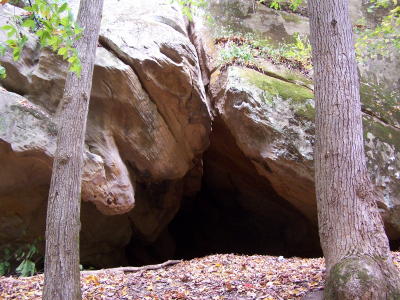
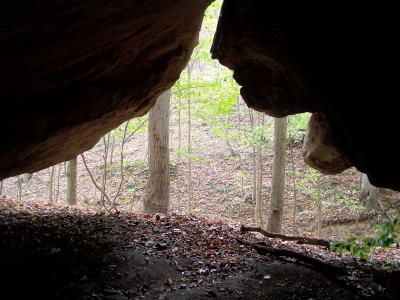
Schoolhouse Cave was site of area's first glimmer of formal
education in 1818, located deep in the woods on Sixteen Ridge, with dates carved on the walls over two centuries ago
By Bob Weaver 2007
Calhoun's famous Schoolhouse Cave rests on a steep hillside above the Little Kanawha River, downriver from Big Bend, close to an early Indian trail that led from Wood County to Gilmer and beyond.
The cave is located on Sixteen Ridge, a peninsula surrounded by the Little Kanawha, near spots on the river known as Fish Pot and Muscle Shoals.
It is the site of the first efforts to conduct a school in 1818.
The first teacher was Robert Clifford, with a class of about a dozen pupils. The seats were made by splitting small logs in half and using wooden pins trestle style, in the oval sides.
School in the cave lasted a few weeks during the fall months with a fire built in one end, a crack in the roof was used as a makeshift chimney.
Settlers built a wall of hewn logs over the entrance, with a small opening covered by cloth.
The Bible was used as a text book with slates in place of pencil and paper, soft limestone was used as chalk.
The late Starling Bartlett was the area's acknowledged guide and historian of the area. He said the school taught simple math and reading letters, but Clifford also taught crop rotation and farming practices.
Historians say the first school building was built in Calhoun in the general area about 1824.
The river trail, still visible today, was traveled by early explorers and settlers before the region was open to commercial riverboat ventures in the late 1800s.
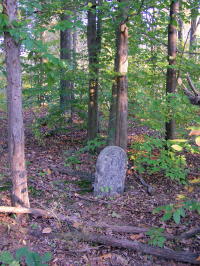
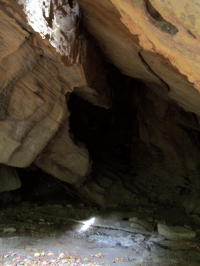
Early Calhoun school teacher John Shed (1861) is buried
in the Sixteen Ridge Cemetery (L) now covered with trees,
markers designating Civil War Union vet Asa Monroe (1831-1899)
and other Monroe family members, with about 60 flagstones marking
unknowns; inside Schoolhouse Cave (R) remnants of a modern bonfire
Mary Ann Barrows, long-time editor of the Calhoun Chronicle, wrote in 1975, that "No doubt this cave has been used for thousands of years since it provides shelter, and come complete with a natural chimney."
Historian Bartlett claimed during the Civil War it was used to hide livestock from bands of soldiers. The river bend area was active with troops moving up and down the Little Kanawha. Bartlett said Civil War Rebel Dan Duskey once hid in a cavity in the back of cave from Union troops.
Early comers to the area were explorers, Jesse Hughes, Elias Hughes and William Lowther in 1772. In 1777 Leonard Petro and William White scouted for hostile Indians on the trail near the cave, and were captured by Indians.
John Dragoo squatted for a while near Big Bend about 1772 and
James Mayse (later Maze) settled in the area about 1814.
Later, settlers made the two-day river-trail trip to take meat and potatoes down the river and return with salt and other supplies.
Schoolhouse Cave, Sixteen Ridge, Katy's Run and the Fairfax Farm are still remote areas, reminders of the struggles early settlers experienced coming to the wilderness.
About a dozen homesteaders once lived in the backwoods area, with faint sign of their habitation.
Several thousand acres of the area are now owned by a timber company, with land in Calhoun and Wirt County.

Schoolhouse Cave rests above the
Little Kanawha River Indian trail ...
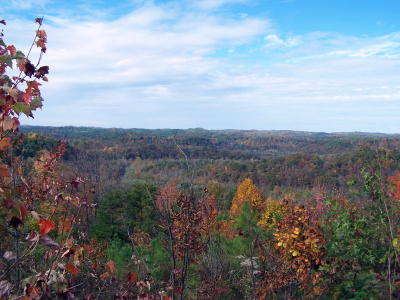
... deep in the Calhoun woods, Fairfax
Farm, Sixteen Ridge, and Kathy's Run section
(Photos by Hur Herald)
| 


